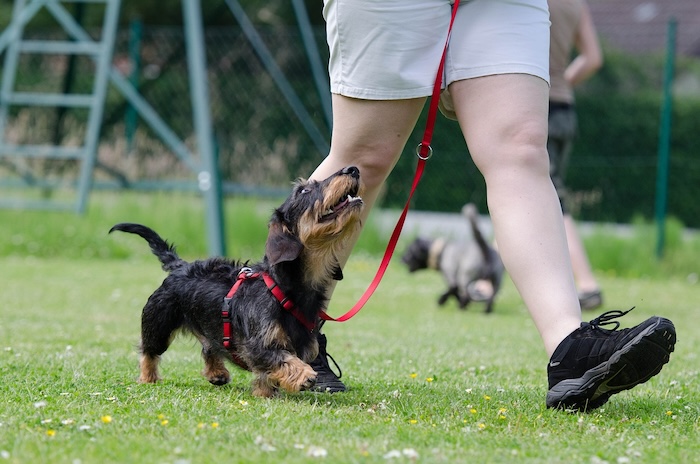Training your dog or puppy is a journey full of challenges and rewards, especially in a vibrant city like Los Angeles. Known for its diverse communities, bustling streets, and beautiful parks, Los Angeles provides a unique backdrop for dog training. From the sunny beaches to the urban landscapes, this city offers various environments where you can train and socialize your dog.
Training in a city environment presents its own set of challenges, such as dealing with distractions and ensuring your dog behaves well in public spaces. Whether you’re a first-time dog owner or looking to brush up on your training skills, this guide will provide valuable insights to help you and your furry friend thrive in the City of Angels.

Let’s dive into these techniques and discover how to build a strong, lasting bond with your canine companion.
1. Exploring Professional Training
Expert trainers work closely with dogs, employing a variety of techniques to ensure effective learning. Boarding schools also offer an immersive environment where dogs can continuously learn and practice new skills. Professional training, such as that offered by “I Said Sit!” School for Dogs, a renowned boarding school for dogs in Los Angeles, provides numerous benefits. These schools offer specialized programs tailored to each dog’s needs, from basic obedience to advanced training.
Top of Form
2. Positive Reinforcement
Positive reinforcement is a cornerstone of effective dog training. For instance, rewarding your dog with a treat for sitting on command reinforces that behavior. It’s essential to deliver the reward immediately after the desired action to create a clear association. Positive reinforcement is not only effective but also builds a bond of trust and cooperation between the dog and the owner.
3. Consistency is Crucial
Consistency in dog training cannot be overstated. Dogs learn best when the rules and expectations are clear and unchanging. This means using the same commands and rewards every time. For example, if you use the command “sit” one day, stick with it; don’t switch to “sit down” the next. Consistency also applies to behavior rules. If jumping on furniture is not allowed, this rule should be enforced at all times. Inconsistent training can confuse dogs and delay their learning process.
4. Patience and Understanding
Training a dog or puppy requires a great deal of patience. Each dog has its own pace of learning, and what works for one may not work for another. It’s important to approach training with a calm and understanding mindset. If a technique isn’t working, it may be necessary to try a different approach rather than getting frustrated. Remember, training is a gradual process, and getting upset or impatient can intimidate the dog and hinder progress.
5. Socialization Skills
Socialization is a critical aspect of a dog’s training, especially in the early stages of life. Proper socialization involves exposing the dog to a variety of people, animals, environments, and experiences. This helps them become well-adjusted and less fearful in different situations. Regular walks in the park, visits to dog-friendly cafes, or playdates with other dogs are effective ways to socialize your pet. A well-socialized dog is generally more confident, relaxed, and easier to train.
6. Clicker Training Methodology
Clicker training is a popular and effective method for teaching dogs new behaviors and commands. A reward, such as a treat, immediately follows the clicker sound. This method relies on the principles of operant conditioning and is highly effective in communicating with your dog. It helps shape behavior and speed up the learning process. The key to clicker training is timing and consistency; the click must occur as the desired behavior happens and then promptly followed by a reward.
7. Leash Training Basics
Leash training is essential for the safety and control of your dog in public spaces. Start by getting your dog comfortable with a collar or harness and leash. Begin training in a quiet, distraction-free environment. Use positive reinforcement to encourage your dog to walk beside you without pulling. If they start to pull, stop walking and wait until they calm down before continuing. Consistency is key. Regular practice and rewarding good behavior on the leash will lead to a well-behaved dog during walks.
8. House Training Strategies
House training is one of the first and most important training areas for a new puppy or dog. It requires consistency, patience, and a routine. Establish a regular schedule for feeding and bathroom breaks. Take your dog to the same spot each time for their bathroom break and reward them immediately after they finish their business. Over time, with consistent reinforcement, your dog will learn to go outside for its bathroom needs.
9. Addressing Behavioral Issues
Addressing behavioral issues is a vital part of dog training. Common problems like barking, chewing, and jumping can be managed with the right training techniques. Identify the cause of the behavior, then use training to address it. For instance, excessive barking might be due to boredom or anxiety. Providing enough mental and physical stimulation can reduce such behaviors. Early intervention is key; the longer a behavior is allowed to continue, the harder it is to change.
10. The Role of Play in Training
Play is an important element in training, serving both as a reward and as a way to teach new skills. Games like fetch, tug-of-war, and hide-and-seek can be used to teach commands such as “come,” “drop it,” or “stay.” Play keeps training sessions fun and engaging for your dog, which boosts their motivation and willingness to learn. It also strengthens the bond between you and your dog, making training a more enjoyable experience for both.

Conclusion
Training your dog or puppy requires a combination of knowledge, patience, and consistency. From professional training options like boarding schools in Los Angeles to fundamental practices like positive reinforcement and clicker training, there are various effective techniques available. Remember, each dog is unique, and what works for one may not work for another. It’s important to be patient, understand your dog’s needs, and adjust your training methods accordingly. Incorporating play and addressing behavioral issues early on will also contribute to a well-behaved and happy dog. Ultimately, the effort put into training your dog is rewarded with a strong, lifelong bond and a pet that is a joy to have in your family.
